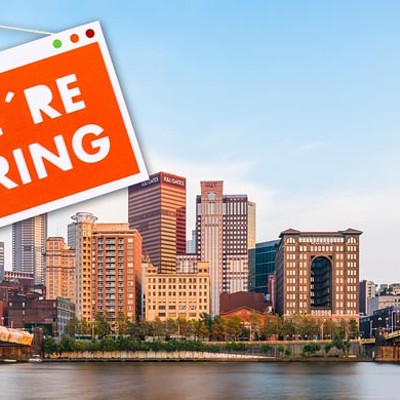What's the historical significance of the "Mexican War Streets" on the North Side?
Question submitted by: Kathleen Mancinelli, Charleroi
The Mexican-American War of 1846-1848, as you may recall from your history books, allowed the United States to seize California and Texas from Mexico. That alone raises the kind of "what if" question that historians love to pose: "If Texas is what we got for winning, how horrible would it have been to lose?"
In fact, given that we planted our flag on Texas, while Mexico got to put its name on Pittsburgh streets, it's hard to be sure who did win the war. To find out, we have to look at the man who named and laid out the War Streets: General William Robinson.
As Story of Old Allegheny City tells it, in 1785 Robinson "had been the first white male child" -- and thus, apparently, the first child whose birth anyone bothered to notice -- "to be born on the site of Allegheny," which is what they called the North Side back then. He was a leading citizen who served in the state militia; when Allegheny City was chartered as a separate municipality in 1840, he became its first mayor. And when he laid out the War Streets a few years later, he named them after the just-completed conflict.
In fact, Robinson was such an enthusiastic supporter for the war that he'd tried to get a 40-year head start on it. According to Old Allegheny City, Robinson had "participat[ed] in the abortive attempt of Aaron Burr to conquer Mexico in 1806."
That would be the same Aaron Burr best known for gunning down Treasury Secretary Alexander Hamilton in a duel. But even stranger than that celebrated gunfight was Burr's apparent attempt to invade Mexico with fewer than 100 men -- not long after serving one term as vice president.
Like many 19th-century Americans, Burr dreamt of empire: an independent nation carved out from Mexican territory in Texas. He rallied support for his cause from military men like Robinson, men who longed to expand westward but doubted Washington's ability to govern the frontier effectively. And in 1806, Burr gathered a small band of supporters and headed for New Orleans -- and from there to Mexico -- on a handful of riverboats.
How Burr planned to take on the entire Mexican Army with such a small force remains a mystery: A co-conspirator turned Burr in before he could launch his campaign. After a trial in front of John Marshall, the first chief justice of the U.S. Supreme Court, Burr was found not guilty of treason. Which seems only fair: If everyone who planned to invade Mexico was convicted of treason, after all, half the U.S. government would have been behind bars in those days.
Indeed, for the next 40 years skirmishes took place between the U.S. and Mexico, including the famed battle of the Alamo and an uprising by Anglos living in Texas. Such developments prompted Burr to observe, "What was treason in me 30 years ago, is patriotism now."
Finally, after one such skirmish, President James Polk had claimed that Mexican troops had "shed American blood on American soil" and asked for a declaration of war in 1846. Among the few dissenters in Congress was a young Abraham Lincoln, who challenged Polk to show where, exactly, on American territory blood could be found.
No doubt this kind of nitpicking was as unwelcome back then as a fussy concern with finding "weapons of mass destruction" in Iraq is today. But as in Iraq, once the war started, its outcome was never in doubt. Mexican forces were numerically superior, but they were badly equipped and often overwhelmed by American artillery. The Mexicans didn't win a single battle, and the war ended in 1848.
Back home in Pittsburgh, meanwhile, William Robinson had given up freelance war-mongering for a slightly more reputable line of work: land speculation.
Robinson's father had been given a tract of land in the heart of the North Side for his service in the Revolutionary War. Up until the 1840s, it had been used to house livestock, but Robinson saw opportunity to capitalize on Allegheny's burgeoning population. He laid out the street grid for a new housing development in 1848, just as the Mexican-American War was winding down. In a burst of patriotism, he named the new streets after famous battle sites and generals. Palo Alto Street is named after the first battle of the Mexican War; Resaca Place after the second -- the battle of Resaca de la Palma. Monterrey and Buena Vista were battle sites as well, the latter being perhaps the decisive conflict of the war. Taylor Street pays homage to Zachary Taylor, the general (and later president) who led the American Army in its Mexican campaign.
The Mexican War Streets, in other words, commemorate a dream of empire and territorial expansion -- no matter what the people living in those territories thought of it. So perhaps it's fitting that in 1907, the neighborhood Robinson laid out -- along with the entire city he once presided over -- was itself annexed by the city of Pittsburgh against its will.
In fact, given that we planted our flag on Texas, while Mexico got to put its name on Pittsburgh streets, it's hard to be sure who did win the war. To find out, we have to look at the man who named and laid out the War Streets: General William Robinson.
As Story of Old Allegheny City tells it, in 1785 Robinson "had been the first white male child" -- and thus, apparently, the first child whose birth anyone bothered to notice -- "to be born on the site of Allegheny," which is what they called the North Side back then. He was a leading citizen who served in the state militia; when Allegheny City was chartered as a separate municipality in 1840, he became its first mayor. And when he laid out the War Streets a few years later, he named them after the just-completed conflict.
In fact, Robinson was such an enthusiastic supporter for the war that he'd tried to get a 40-year head start on it. According to Old Allegheny City, Robinson had "participat[ed] in the abortive attempt of Aaron Burr to conquer Mexico in 1806."
That would be the same Aaron Burr best known for gunning down Treasury Secretary Alexander Hamilton in a duel. But even stranger than that celebrated gunfight was Burr's apparent attempt to invade Mexico with fewer than 100 men -- not long after serving one term as vice president.
Like many 19th-century Americans, Burr dreamt of empire: an independent nation carved out from Mexican territory in Texas. He rallied support for his cause from military men like Robinson, men who longed to expand westward but doubted Washington's ability to govern the frontier effectively. And in 1806, Burr gathered a small band of supporters and headed for New Orleans -- and from there to Mexico -- on a handful of riverboats.
How Burr planned to take on the entire Mexican Army with such a small force remains a mystery: A co-conspirator turned Burr in before he could launch his campaign. After a trial in front of John Marshall, the first chief justice of the U.S. Supreme Court, Burr was found not guilty of treason. Which seems only fair: If everyone who planned to invade Mexico was convicted of treason, after all, half the U.S. government would have been behind bars in those days.
Indeed, for the next 40 years skirmishes took place between the U.S. and Mexico, including the famed battle of the Alamo and an uprising by Anglos living in Texas. Such developments prompted Burr to observe, "What was treason in me 30 years ago, is patriotism now."
Finally, after one such skirmish, President James Polk had claimed that Mexican troops had "shed American blood on American soil" and asked for a declaration of war in 1846. Among the few dissenters in Congress was a young Abraham Lincoln, who challenged Polk to show where, exactly, on American territory blood could be found.
No doubt this kind of nitpicking was as unwelcome back then as a fussy concern with finding "weapons of mass destruction" in Iraq is today. But as in Iraq, once the war started, its outcome was never in doubt. Mexican forces were numerically superior, but they were badly equipped and often overwhelmed by American artillery. The Mexicans didn't win a single battle, and the war ended in 1848.
Back home in Pittsburgh, meanwhile, William Robinson had given up freelance war-mongering for a slightly more reputable line of work: land speculation.
Robinson's father had been given a tract of land in the heart of the North Side for his service in the Revolutionary War. Up until the 1840s, it had been used to house livestock, but Robinson saw opportunity to capitalize on Allegheny's burgeoning population. He laid out the street grid for a new housing development in 1848, just as the Mexican-American War was winding down. In a burst of patriotism, he named the new streets after famous battle sites and generals. Palo Alto Street is named after the first battle of the Mexican War; Resaca Place after the second -- the battle of Resaca de la Palma. Monterrey and Buena Vista were battle sites as well, the latter being perhaps the decisive conflict of the war. Taylor Street pays homage to Zachary Taylor, the general (and later president) who led the American Army in its Mexican campaign.
The Mexican War Streets, in other words, commemorate a dream of empire and territorial expansion -- no matter what the people living in those territories thought of it. So perhaps it's fitting that in 1907, the neighborhood Robinson laid out -- along with the entire city he once presided over -- was itself annexed by the city of Pittsburgh against its will.










